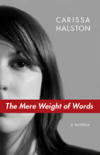The Mere Weight of Words
Carissa Halston was born in the wrong time. Her careful, precise use of language and acute awareness of the nuances in each painstakingly chosen word seem like attributes more suited to a woman from Emily Dickinson’s era. Yet, Halston’s novella The Mere Weight of Words, first and foremost a tale of language, is rooted in today’s world through her examination of how casually words can be used. Indeed, words are tossed, sometimes thrown, by those closest to Meredith, the book’s protagonist. In response, Meredith is something of a solitary person. In fact, she works to maintain this self-imposed isolation as she regularly uses her own deep knowledge of language to expand the chasm between herself and the people in her life. Readers will spend much of their time alone with Meredith as she grapples with her numerous demons.
Carissa Halston was born in the wrong time. Her careful, precise use of language and acute awareness of the nuances in each painstakingly chosen word seem like attributes more suited to a woman from Emily Dickinson’s era. Yet, Halston’s novella The Mere Weight of Words, first and foremost a tale of language, is rooted in today’s world through her examination of how casually words can be used. Indeed, words are tossed, sometimes thrown, by those closest to Meredith, the book’s protagonist. In response, Meredith is something of a solitary person. In fact, she works to maintain this self-imposed isolation as she regularly uses her own deep knowledge of language to expand the chasm between herself and the people in her life. Readers will spend much of their time alone with Meredith as she grapples with her numerous demons.
Meredith’s own vision of herself—and indeed Halston’s own aesthetic—can be ascertained by examining Meredith’s preferred nickname, “Mere.” Halston writes:
. . . my father chose Meredith, from which I culled Mere.
mere – adj. – Having no greater extent, range, value, power, or importance than the designation implies; that is barely or only what it is said to be
Only what it is said to be. I chose this adjective eons ago, as mine to shoulder when nothing else suited me. How fitting that I wrought such a name from my father.
In just a few strokes, Halston easily conveys Mere’s own diminished sense of self-worth and also the extreme dysfunction that characterizes Mere’s relationship with her father. These simple details underscore what readers will quickly understand. This is not just a tale about language; at its core, it is about the difficulty in forging lasting human relationships. Mere struggles to do this particularly in her relationship with her father, a prominent filmmaker. However, Mere’s struggles with interpersonal relationships extend beyond the foundational father-daughter interplay and into her romantic relationships. Not surprisingly, Mere chooses a man who challenges her in ways strongly reminiscent of her father. The portions of the book featuring Mere’s and Patrick’s troubled romance provide some of Halston’s sharpest writing. In these sections, Halston displays Mere’s vulnerability and incisive wit in the simplest of exchanges: “I don’t recall whose idea it was, but during our final year of study, we were living together. ‘Patricia.’ The name was my commentary on our mounting domesticity. . . . ‘Patricia,’ I repeated, sliding my dagger in beneath a sweetness of tone.” Mere’s feminization of Patrick’s name speaks volumes about her own disdain for domestic life, her discomfort in personal relationships, and her pervading fear.
Halston certainly understands what motivates her character, and that is the real source of power in this novella. For many readers, the strength of the writing and the language will make up for the fact that the narrative leaves many areas unexplored. Mere’s visit to her father and their stilted exchange after his Alzheimer’s diagnosis could arguably take up its own novel. Likewise, Mere’s struggle with Bell’s Palsy should receive a bit more attention. However, readers can forgive these flaws simply because Halston’s prose is so pleasant to read. It’s clear that Halston has a way with words, and she has no doubt earned the devotion of a new set of readers with this volume.





